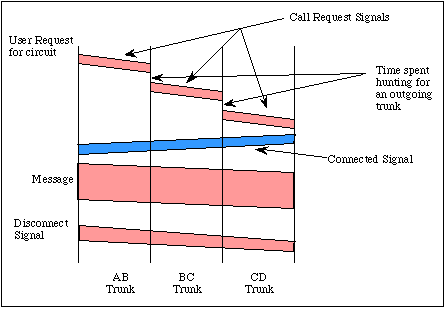
Circuit switching is the most familiar technique used to build a communications network. It is used for ordinary telephone calls. It allows communications equipment and circuits, to be shared among users. Each user has sole access to a circuit (functionally equivalent to a pair of copper wires) during network use. Consider communication between two points A and D in a network. The connection between A and D is provided using (shared) links between two other pieces of equipment, B and C.

A connection between two systems A & D formed from 3 links
Network use is initiated by a connection phase, during which a circuit is set up between source and destination, and terminated by a disconnect phase. These phases, with associated timings, are illustrated in the figure below.

A circuit switched connection between A and D
(Information flows in two directions. Information sent from the calling end is shown in pink and information returned from the remote end is shown in blue)
After a user requests a circuit, the desired destination address must be communicated to the local switching node (B). In a telephony network, this is achieved by dialing the number.
Node B receives the connection request and identifies a path to the destination (D) via an intermediate node (C). This is followed by a circuit connection phase handled by the switching nodes and initiated by allocating a free circuit to C (link BC), followed by transmission of a call request signal from node B to node C. In turn, node C allocates a link (CD) and the request is then passed to node D after a similar delay.
The circuit is then established and may be used. While it is available for use, resources (i.e. in the intermediate equipment at B and C) and capacity on the links between the equipment are dedicated to the use of the circuit.
After completion of the connection, a signal confirming circuit establishment (a connect signal in the diagram) is returned; this flows directly back to node A with no search delays since the circuit has been established. Transfer of the data in the message then begins. After data transfer, the circuit is disconnected; a simple disconnect phase is included after the end of the data transmission.
Delays for setting up a circuit connection can be high, especially if ordinary telephone equipment is used. Call setup time with conventional equipment is typically on the order of 5 to 25 seconds after completion of dialing. New fast circuit switching techniques can reduce delays. Trade-offs between circuit switching and other types of switching depend strongly on switching times.
See also